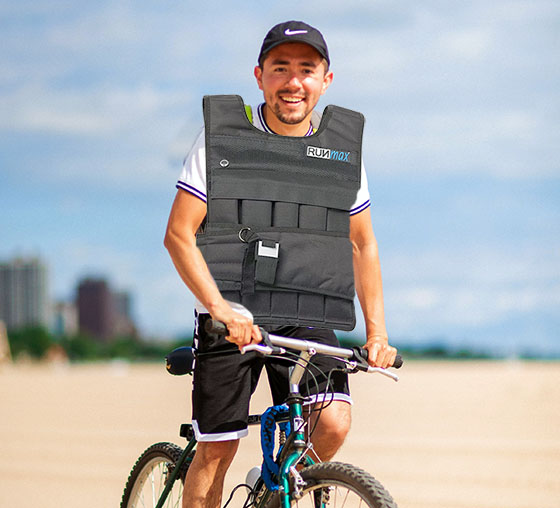Weighing yourself isn’t that hard. You just step on the scale and read the number.
But some people make a big deal out of the weighing process because of the anxiety that centers around the number they’re faced with. So they weigh themselves multiple times per day, obsessing over it, or they don’t weigh themselves at all.
There is a happy-medium though! It is… weigh yourself once per day.
It doesn’t matter if you’re dieting or not. It does matter if you’re keeping a training log (you are keeping a training log, right?)
An important piece of information for your training log is your weight. Since there is an entry space for “body weight” in most every training log, it makes sense to weigh yourself once per day to obtain that number.
To get the best results, though, you need to be more precise than “once per day.” You need to weigh yourself at the same time every day.
That way you’ll get much more consistent and reliable numbers. You could choose morning, afternoon, or evening (whatever is most convenient), but I do suggest weighing yourself in the morning after using the bathroom, but before eating breakfast.
The morning is the best time to weigh yourself. You’re probably near the scale anyway, and weighing in the morning cuts out quite a few variables that you run into throughout the day, such as food intake, fluid intake, sweating, etc.
There are two major benefits to daily weighing:
- You can better chart your weight fluctuations over time.
- You’ll be alerted to any potential problems more quickly.
Problems? What problems?
For example, if you lost five pounds overnight, chances are you are dehydrated and need to drink lots of fluids!
Table of Contents
“Don’t Weigh Yourself Every Day!”
I can hear them now. The so-called weight loss experts will scream “don’t weigh yourself every day”, but that advice is just for dieters who freak out when they look at a scale.
As in, “OMG I ate 900 calories yesterday but I’m one pound heavier today! Nooo! Only 300 calories today then.”
That’s not you. You’re smarter than that. You want to see the daily fluctuations because it’s an important piece of data.
You can compare your weight to what you’re eating and to the exercise you’re doing, and figure out if you are balanced. As I mentioned, a sudden weight drop is a good indication that you’re dehydrated (be sure to do a sweat rate test to help avoid that) or perhaps you’ve been on a low carb diet and have very little water retention, so you’re kind of dehydrated… either way, probably not a good way to start a race.
Weighing once per day makes sense for everyone though (athletes and dieters alike).
That’s because when weighing just once per week, you could have huge ups and downs. Let’s say you weigh yourself for a week and get these numbers (which is typical for me):
159, 162, 160, 161, 157, 160, 160, 164
Those fluctuations are natural for an athlete in training, and everything seems alright when you see the pattern.
But if I weighed myself once per week, I’d only have 159 and then 164. It would seem like I gained five pounds!
Maybe I was dehydrated one day. Maybe I ate too many doughnuts the last day? Maybe I had gone up to 175 midweek but luckily got down to 164 for weigh-in day? Who knows!
If you only weigh yourself weekly or monthly, the numbers can be deceptive.
The Easy Way to Track Your Weight Daily
You probably have a smartphone. And you probably use apps to track your diet and fitness. So… get a scale that automatically sends your weight to your apps!
It’s simple. Here’s how I do it:
I have a Weight Gurus smart scale which is connected to my home Wi-fi. When I weigh myself each morning, it sends my data to the Weight Gurus app on my iPhone. Then that app pushes the data to the Apple Health app (which pulls in my biometric data from other apps and fitness trackers as well).
That allows me to track my weight fluctuations and see progress charts whenever I desire.
The Moral of the Story
Once you get past the needless debates, it’s very simple…
Weigh yourself each morning and record it in your training log (or app). Just keep it simple, don’t get hung up on day-to-day fluctuations (it’s not the end of the world), and you’ll be fine.
[This article was first published on Feb 3, 2009. It was edited and last updated on May 14, 2018.]
Levi Bloom is an experienced endurance athlete who has been training and competing for over 17 years. A former Cat 1 road and mountain bike racer (professional class on the regional circuit), he is now a cycling coach (USA Cycling Level 3 Certified) and sports nutrition coach (Precision Nutrition Level 1 Certified).










Sometimes I cannot wrap my brain around all the daily fluctuations.
@Andrea
Sometimes it makes no sense! The human body is mysterious, huh?
And then do a 7 day rolling average?
@Chad
That is one way to do it!
I’m loosing weight but I still look the same! Please help!!
@Pam
That’s one of the downfalls of just going by weight. It doesn’t tell you if you’re losing fat or muscle. It sounds like you could be losing fat and muscle equally, which unfortunately doesn’t help you to look more slender or athletic.